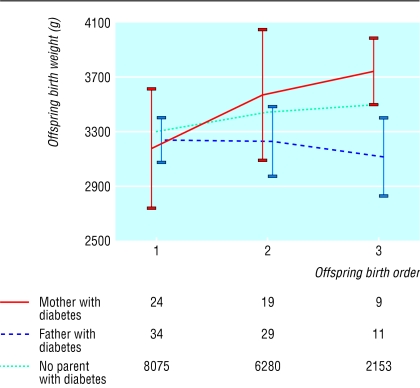According to the fetal insulin hypothesis, shared genetic factors lead to suboptimal prenatal growth and to insulin resistance in the parent's later life.1 If this is true, we expect non-insulin dependent diabetes in parents to be associated with lower birth weight among their offspring. Some evidence supports an inverse association between birth weight of offspring and paternal diabetes.2,3 The association between fetal macrosomia and a mother's diabetes during pregnancy has been established,4 however this is likely to be caused by acute metabolic effects. We used data from the large cohort study of British births in 1958 to evaluate whether a father's non-insulin dependent diabetes or a mother's diabetes starting after childbirth is associated with the birth weight of their offspring.
Participants, methods, and results
Members of the cohort were born during the week 3-9 March 1958.5 Between 1999 and 2000, 96 cohort members reported having diabetes (controlled by diet or tablets). We excluded participants with other types of diabetes (n=100).
Of the 11 276 participants contacted at age 41 years, 3777 mothers and 4364 fathers gave information on the birth characteristics for at least one (range 1-9) singleton liveborn child. A total of 34 men with diabetes had had children, and 24 women had become diabetic after childbirth. We used random effects models on birth weight (adjusted for gestational age) to allow for dependence between a parent's subsequent births. North Thames Multicentre Research Ethics Committee approved the 41 year survey.
The offspring of the fathers with diabetes weighed on average less by a difference of −186 g (95% confidence interval −330 g to −44 g) than other children (figure). Father's adult height or social class did not explain the association between a father's diabetes and the birth weight of his offspring. The child's birth order made no difference to the effect of a father's diabetes on the birth weight of his offspring (P=0.21).
The mean difference in the birth weight of offspring between diabetic and non-diabetic women (133 g; −29 g to 296 g) was not significant (P=0.11), but there was a positive interaction between mother's diabetes and child's birth order (P<0.001) (figure). The association between mother's diabetes and offspring birth weight seen in second born and subsequent births was not seen for first born babies (difference +15 g; −172 g to 202 g). The data showed a decrease in birth weight per year from birth to the onset of diabetes in the mother (change per year of −54 g; −147 g to 38 g).
When we restricted the analysis to first born babies born at least 10 years before the onset of the mother's diabetes (n=17), offspring had lower birth weight (decrease of 156 g; −377 g to 65 g).
Comment
Diabetes in fathers and the birth weight of their offspring are strongly associated, according to data from the 1958 birth cohort. Our finding is consistent with reports of increased risk of non-insulin dependent diabetes for the fathers of children with low birth weight in native Americans and Swedish populations.2,3
In contrast to the paternal effect, diabetes in the mother increases the birth weight of offspring.4 The association between maternal diabetes and the child's birth weight, however, is likely to reflect immediate effects of the mother's metabolic control, possibly masking genetic effects operating in the opposite direction. We observed some evidence for a lower birth weight for offspring of the mothers who were likely to have been free of metabolic disturbances related to diabetes at the time of childbirth.
The interaction between birth order and diabetes for mothers (not fathers) may also reflect the different intervals between the onset of diabetes and the timing of births. Our findings support the hypothesis that common genetic factors contribute both to the risk of non-insulin dependent diabetes and decreased prenatal growth.1
Figure.
Birth weight of offspring as a function of birth order for parents with or without diabetes; numbers relate to each birth order. Error bars are 95% confidence intervals
Acknowledgments
We thank Leah Li for computational advice and Peter Shepherd for advice on the data. We took data from the National Child Development Survey's composite file including selected perinatal data and sweeps one to five, Centre for Longitudinal Studies, Institute of Education, National Birthday Trust Fund, National Children's Bureau, City University, Social Statistics Research Unit, and Data Archive Distributor, Colchester, Essex.
Footnotes
Funding: Wellcome Trust.
Competing interests: None declared.
References
- 1.Hattersley AT, Tooke JE. The fetal insulin hypothesis: an alternative explanation of the association of low birth weight with diabetes and vascular disease. Lancet. 1999;353:1789–1792. doi: 10.1016/S0140-6736(98)07546-1. [DOI] [PubMed] [Google Scholar]
- 2.Lindsay RS, Dabelea D, Roumain J, Hanson RL, Bennett PH, Knowler WC. Type 2 diabetes and low birth weight: the role of paternal inheritance in the association of low birth weight and diabetes. Diabetes. 2000;49:445–449. doi: 10.2337/diabetes.49.3.445. [DOI] [PubMed] [Google Scholar]
- 3.Rasmussen F, Davey Smith G, Sterne J, Tynelius P, Leon DA. Birth char-acteristics of offspring and parental diabetes. Am J Epidemiol. 2001;153(suppl):S47. doi: 10.1136/jech.58.2.126. [DOI] [PMC free article] [PubMed] [Google Scholar]
- 4.Pennison EH, Egerman RS. Perinatal outcomes in gestational diabetes: a comparison of criteria for diagnosis. Am J Obstet Gynecol. 2001;184:1118–1121. doi: 10.1067/mob.2001.114918. [DOI] [PubMed] [Google Scholar]
- 5.Butler NR, Bonham DG. Perinatal mortality. Edinburgh: Livingstone; 1963. [Google Scholar]



